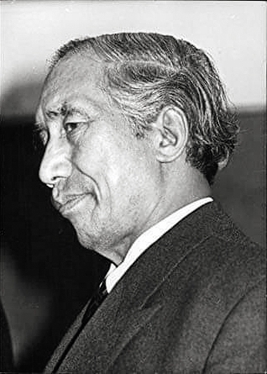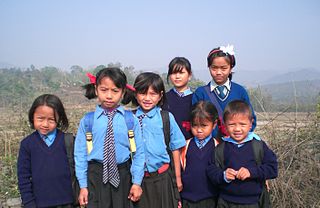
The Insurgency in Northeast India involves multiple separatist militant groups operating in some of India's northeastern states, which are connected to the rest of India by the Siliguri Corridor, a strip of land as narrow as 14.29 miles (23.00 km) wide.

Zapu Phizo, commonly known as A. Z. Phizo or Angami Zapu Phizo, was a Naga nationalist leader with British nationality. Under his influence, the Naga National Council asserted the right to self-determination which took the shape of armed resistance after the Indian state imposed the Armed Forces Special Powers Act in 1958. Naga secessionist groups regard him as the "Father of the Naga Nation".

The insurgency in Nagaland, in northeastern India, is an ongoing conflict fought between the ethnic Nagas and the governments of India. Nagaland inhabited by the Nagas is located at the tri-junction border of India on the West and South, north and Myanmar on the East.

Gaidinliu Pamei popularly known as Rani Gaidinliu was a Naga spiritual and political leader who led a revolt against British rule in India. At the age of 13, she joined the Heraka religious movement of her cousin Haipou Jadonang. The movement later turned into a political movement seeking to drive out the British from Manipur and the surrounding Naga areas. Within the Heraka faith, she came to be considered an incarnation of the Goddess Cherachamdinliu. Gaidinliu was arrested in 1932 at the age of 16, and was sentenced to life imprisonment by the British rulers. Jawaharlal Nehru met her at Shillong Jail in 1937, and promised to pursue her release. Nehru gave her the title of "Rani" ("Queen"), and she gained local popularity as Rani Gaidinliu.

The National Socialist Council of Nagaland (NSCN) is a Naga militant and separatist group operating mainly in northeastern part of India, with minor activities in northwest Myanmar (Burma). The main aim of the organisation is allegedly to establish a sovereign Naga state, "Nagalim", which would consist of all the areas inhabited by Naga tribes in Northeast India and northwest Myanmar.China and Pakistan provide financial support and weaponry to the NSCN. Drug trafficking and extortion are believed to be other major sources of income for the NSCN.
The Naga National Council (NNC) is a political organization of Naga people, active from the late 1940s to the early 1950s. It evolved out of the Naga Hills District Tribal Council, an organization established in 1945 by the Deputy Commissioner of the Naga Hills district. The group was reorganized to form NNC in 1946 at Sanis, with Eno T. Aliba Imti Ao as the President, and other democratically elected Naga representatives as its members. Later, NNC declared Independence one day ahead of India i.e. on 14 August 1947.
Zeliangrong people are one of the major indigenous Naga communities living in the tri-junction of Assam, Manipur and Nagaland in India. They are the descendants of Nguiba. The term "Zeliangrong" refers to the Zeme, Liangmai and Rongmei Naga tribes combined. Earlier, the term also covered the Inpui tribe. The descendants of Hoi of Makuilongdi (Makhel) were divided and were made peripheral appendages to three political entities - Manipur, Naga Hills (Nagaland) and the Dima Hasao of Assam. The Zeliangrong may be classified as an ethno-cultural entity. The Zeliangrong belong to the larger Southern Mongoloid population and their language belongs to the Sino-Tibetan family of languages.
The Naga Hills District was a former district of the Assam province of British India. Located in the Naga Hills, it was mainly inhabited by the Naga ethnic groups. The area is now part of the state of Nagaland.
Longri Ao (1906–1981), also known by name Longritangchetha, was an indigenenous Baptist missionary from the North-Eastern state of India, Nagaland. He was a missionary to the Konyak people and a peacemaker. He is known to have risked his life to restore peace in Nagaland, and to negotiate a ceasefire agreement between the Government of India and underground leaders fighting for Nagaland secession from India.
The Shillong Accord of 1975 was an agreement signed between the Government of India, also referred to as the Federal government, or Union government, or Central government of India, and Nagaland's underground government, also referred to as the Naga Federal government, or Naga guerillas, or Naga rebels, to accept the supremacy of Constitution of India without condition, surrender their arms and renounce their demand for the secession of Nagaland from India.
Jadonang Malangmei (1905-1931), popularly known as Haipou Jadonang, was a Naga spiritual leader and political activist from Manipur, British India. He established the Heraka religious movement, which was based on the ancestral Naga religion, and declared himself to be the "messiah king" of the Nagas. His movement was widespread in the Zeliangrong territory before the conversion to Christianity. He also espoused the cause of an independent Naga kingdom, which brought him in conflict with the colonial British rulers of India. He was hanged by the British in 1931, and succeeded by his cousin Rani Gaidinliu.
Rungsung Suisa was an Indian politician. Suisa was one of the key figures in the movement to unite Naga-populated areas in Manipur with the Naga Hills (Nagaland). He was popularly known as 'Uncle Suisa'.
Thuingaleng Muivah is an Indian politician and General Secretary of the National Socialist Council of Nagaland(I-M).
The Naga Peace Accord is a peace treaty, signed, on 3 August 2015, between the Government of India, and the National Socialist Council of Nagaland (NSCN), to end the insurgency in the state of Nagaland in Northeast India. The Government’s interlocutor for Naga Peace Talks, R. N. Ravi signed it on behalf of the Government of India, whereas Lt. Isak Chishi Swu, Chairman and Thuingaleng Muivah, General Secretary signed on behalf of the NSCN, in presence of the Indian Prime Minister, Narendra Modi.
Isak Chishi Swu was the chairman of the Nationalist Socialist Council of Nagaland (NSCN). He along with Thuingaleng Muivah and S. S. Khaplang were instrumental in the creation of NSCN on 31 January 1980 after opposing the 'Shillong Accord' signed by the then Naga National Council (NNC) with the Indian government. He was unable to attend the historic Naga Framework Agreement signed on 4 August 2015 due to health conditions.

Shangwang Shangyung Khaplang was a Burmese leader of Naga ethnicity. He was the leader of the NSCN-K, an insurgent group that operates to establish a Greater Nagaland, a sovereign state bringing all Naga-inhabited areas of Myanmar and India under one administrative setup.

The hill tribes of Northeast India are hill people, mostly classified as Scheduled Tribes (STs), who live in the Northeast India region. This region has the largest proportion of scheduled tribes in the country.

The history of the Nagas dates back centuries, but first appear in written records of Ahom kingdom during the medieval period of Indian history. Aside from developing contacts with the Ahom kingdom, which was established in 1228 in Assam, the Nagas generally lived an isolated existence from the outside world. This changed in the 19th century, when the Burmese Empire launched several invasions of Assam between 1817 and 1826, which led the Nagas to briefly fall under Burmese rule. However, the neighboring British Empire annexed Assam in 1828 following the 1826 Treaty of Yandabo.
This is a timeline of the history of the Nagas.
In 1992, violent clashes broke out between two tribal groups, the Nagas, and the Kukis, in the northeastern Indian state of Manipur. The clashes affected all five hill districts in the state - Chandel, Churachandpur, Senapati, Tameglong, and Ukhrul districts. Of these five, Chandel was the most troubled and affected district. Though it was popularly known as the Kuki-Naga clash, many other tribes of the Chin-Kuki-Mizo group were also affected.








